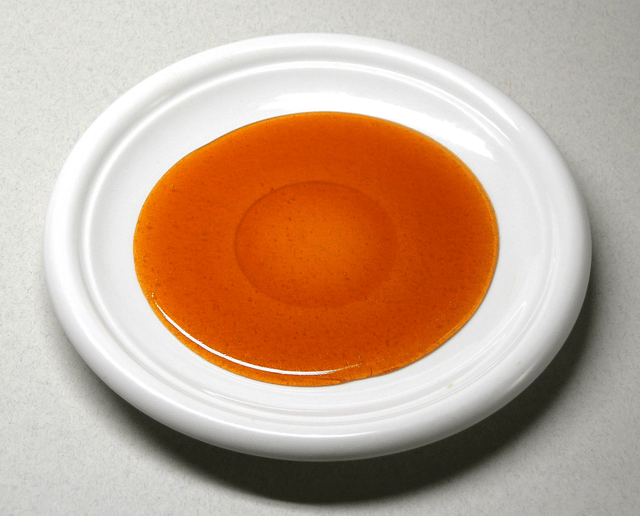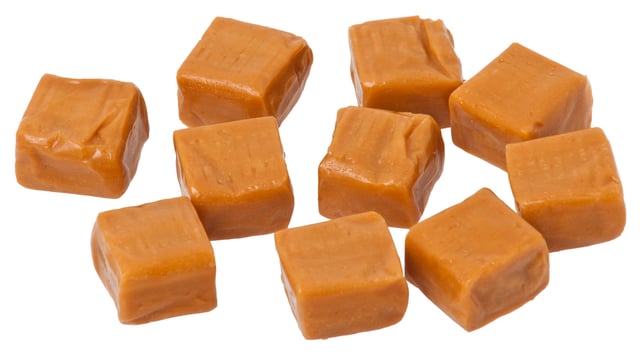Caramel

Caramel

| Course | Dessert or Snack |
|---|---|
| Place of origin | Various Countries of Origin |
| Region or state | English |
| Created by | Various Claims |
| Main ingredients | Sugar |
| Variations | brittles,pralines,crème brûlée,crème caramel, andcaramel apple |
Caramel (/ˈkærəmɛl/ or /ˈkɑːrməl/[1]%20%283rd%20ed.%29.%20New%20Yo]][[2]](https://openlibrary.org/search?q= [[CITE|2|https://openlibrary.org/search?q=*The%20American%20Heritage%20Dictionary%20of%20the%20English%20L)confectionery sugars be used as a flavoring in puddings and desserts, as a filling in bonbons, or as a topping for ice cream and custard.
The process of caramelization consists of heating sugar slowly to around 170 °C (338 °F). As the sugar heats, the molecules break down and re-form into compounds with a characteristic color and flavor.
A variety of candies, desserts, toppings, and confections are made with caramel: brittles, nougats, pralines, flan, crème brûlée, crème caramel, and caramel apples. Ice creams sometimes are flavored with or contain swirls of caramel.[3]
| Course | Dessert or Snack |
|---|---|
| Place of origin | Various Countries of Origin |
| Region or state | English |
| Created by | Various Claims |
| Main ingredients | Sugar |
| Variations | brittles,pralines,crème brûlée,crème caramel, andcaramel apple |
Etymology
The English word comes from French caramel, borrowed from Spanish caramelo (18th century), itself possibly from Portuguese caramel.[4]%2C%205th%20edition%2C%202011%2C]]Most likely that comes from Late Latin 'sugar cane', a diminutive of 'reed, cane', itself from Greek κάλαμος. Less likely, it comes from a Medieval Latin, from 'cane' + la*'honey'.[5] Finally, some dictionaries connect it to an Arabic* kora-moħalláh*'ball of sweet'.[[6]](https://openlibrary.org/search?q=Littr%C3%A9%2C%20* [[CITE|6|https://openlibrary.org/search?q=Littr%C3%A9%2C%20Dictionnaire%20de%20la%20langue%20fran%C3%A7aise%2C%20*s.)[7]
Caramel sauce
Caramel sauce is made by mixing caramelized sugar with cream. Depending on the intended application, additional ingredients such as butter, fruit purees, liquors, or vanilla can be used. Caramel sauce is used in a variety of desserts, especially as a topping for ice cream. When it is used for crème caramel or flan, it is known as clear caramel and only contains caramelized sugar and water. Butterscotch sauce is made with dark brown sugar, butter, and often a splash of whiskey. Traditionally, butterscotch is a hard candy more in line with a toffee, with the suffix "scotch" meaning "to score".
Toffee

Milk caramel manufactured as square candies, either for eating or for melting down.
Toffee, sometimes called "caramel candy", is a soft, dense, chewy candy made by boiling a mixture of milk or cream, sugar(s), glucose, butter, and vanilla (or vanilla flavoring). The sugar and glucose are heated separately to reach 130 °C (270 °F); the cream and butter are then added which cools the mixture. The mixture is then stirred and reheated until it reaches 120 °C (250 °F). Upon completion of cooking, vanilla or any additional flavorings and salt are added. Adding the vanilla or flavorings earlier would result in them burning off at the high temperatures. Adding salt earlier in the process would result in inverting the sugars as they cooked.
Alternatively, all ingredients may be cooked together.
In this procedure, the mixture is not heated above the firm ball stage (120 °C [250 °F]), so that caramelization of the milk occurs. This temperature is not high enough to caramelize sugar and this type of candy is often called milk caramel or cream caramel.
Salted caramel
Salted caramel is a noticeably salty variant.
It was invented in 1977 by the French pastry chef Henri Le Roux in Quiberon, Brittany, in the form of a salted butter caramel with crushed nuts (caramel au beurre salé), using the famous Breton demi-sel butter.[8] It was named the "Best Candy in France" (Meilleur Bonbon de France) at the Paris Salon International de la Confiserie in 1980.
Then in the late 1990s, the Parisian pastry chef Pierre Hermé introduced his salted butter and caramel macaroons and, by 2000, high-end chefs started adding a bit of salt to caramel and chocolate dishes. It was only in 2008, though, that it took off and entered the mass market, when Häagen-Dazs and Starbucks started selling it.[9]
Originally utilised in desserts, the confection has seen wide use elsewhere, including in hot chocolate and spirits such as vodka. Its popularity may come from its effects on the reward systems of the human brain, resulting in "hedonic escalation".[10]
Caramel colouring
Caramel colouring, a dark, bitter liquid, is the highly concentrated product of near total caramelization, used commercially as food and beverage colouring, e.g., in cola.
Chemistry
Caramelization is the removal of water from a sugar, proceeding to isomerization and polymerization of the sugars into various high-molecular-weight compounds. Compounds such as difructose anhydride may be created from the monosaccharides after water loss. Fragmentation reactions result in low-molecular-weight compounds that may be volatile and may contribute to flavor. Polymerization reactions lead to larger-molecular-weight compounds that contribute to the dark-brown color.[11]
In modern recipes and in commercial production, glucose (from corn syrup or wheat) or invert sugar is added to prevent crystallization, making up 10%–50% of the sugars by mass. "Wet caramels" made by heating sucrose and water instead of sucrose alone produce their own invert sugar due to thermal reaction, but not necessarily enough to prevent crystallization in traditional recipes.[12]
Nutritional information
Four and six tenths tablespoons (i.e., 69 grams) of commercially prepared butterscotch or caramel topping contain:[13]
Calories (kcal): 103
Protein (g): 0.62
Total lipids (fat): 0.04
Carbohydrates, by difference (g): 27.02
Fiber, total dietary (g): 0.4
Cholesterol (mg): 0.0
See also
Caramel corn, popcorn coated in caramel
Confiture de lait, caramelized, sweetened milk
Dodol, a caramelized confection made with coconut milk
Dulce de leche, caramelized, sweetened milk
Maillard reaction
Tablet, Scottish candy made with condensed milk
Toffee, a type of candy